Exploring My Paris Neighborhood: A Lockdown Lesson
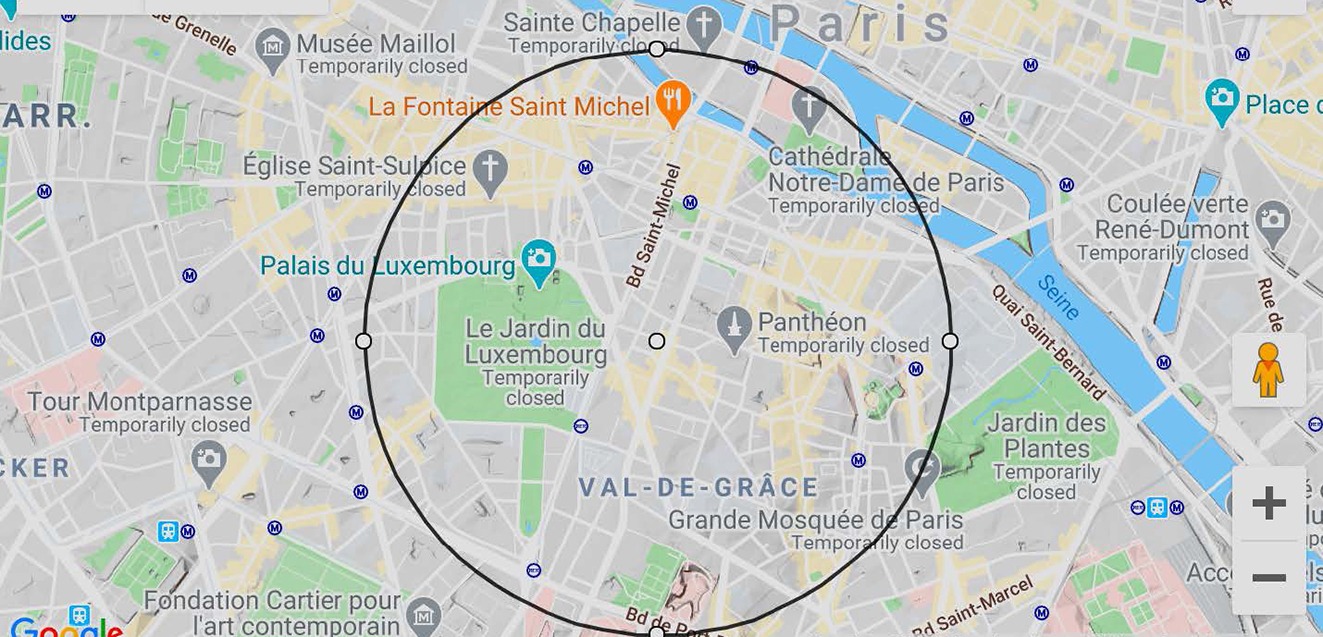
I have traveled all my life. In 1963, at age 11, I set off on my first overseas adventure on an educational school cruise aboard the Devonia, a converted troopship built in 1939 that carried school parties to Scandinavian, Atlantic, and Mediterranean ports. I was on the Mediterranean voyage. We visited Vigo, Cadiz, Gibraltar, and Tangiers. We should have visited the Azores, but force 10 gales in the Bay of Biscay prevented us from venturing far from the coastal waters.
This journey was the beginning of a life spent traveling. Now, more than 50 years later, with a countless number of countries and adventures under my belt, I began 2020 much as I usually do: leading groups on expeditions. January began with an overland journey through Bhutan. The weather was spectacularly clear, as it often is in the winter, with bright blue skies showing off the pristine Himalayan peaks at their best. February brought a complete contrast: I was in Saudi Arabia with a dozen adventurous souls seeking to discover an enigmatic country so long closed to tourism. Here, in contrast to the mountains, we were plunged into the Arabian sands. Immediately following this, I was briefly in Bangkok before returning once again to Bhutan with a new group of travelers.
The rest of the year was carefully planned: China and Bhutan in April, Pakistan twice in the summer and twice in the autumn, Laos and Cambodia in November, and then another return to Saudi Arabia before hitting Southern Pakistan in December.
Much of my 45 years as a travel guide, explorer, and raconteur have been spent this way. In between trips, I’ve called a number of countries home: England, Germany, Seychelles, an interesting year in Hollywood, China, Hong Kong, and—for the last 20 years—Paris, France, where I live in the very heart of this stunningly beautiful city. Yet despite making my living traveling, I have not, until now, really examined the area where I live.
I left Bhutan on March 8, a day that coincided with its first coronavirus case. The government promptly closed the country. Within a week of returning to Paris, travel around the world pretty much stopped. All my future tours were canceled as each country very quickly took the unprecedented step to lockdown.
A week later in a televised speech to the nation, French President Emmanuel Macron announced several times “nous sommes en guerre” (“we are at war”). While calling on the French people to “keep calm,” he ordered extraordinary measures never before taken in peacetime. People would be allowed to leave their homes only for necessary outings for the next 15 days, with foreseeable extensions to this initial period as the pandemic progressed. At the time of writing this, we are starting week 7 of home confinement.
We now know that this was only the beginning of a worldwide lockdown, resulting in compulsory confinement with outings restricted to one’s immediate vicinity. For those of us in Paris, this was to be limited to a radius of 1 kilometer of where we live. For someone who has spent most of his life exploring the world without constraints and who lives by a motto of “relish the unexpected,” the lockdown came as a challenging shock.
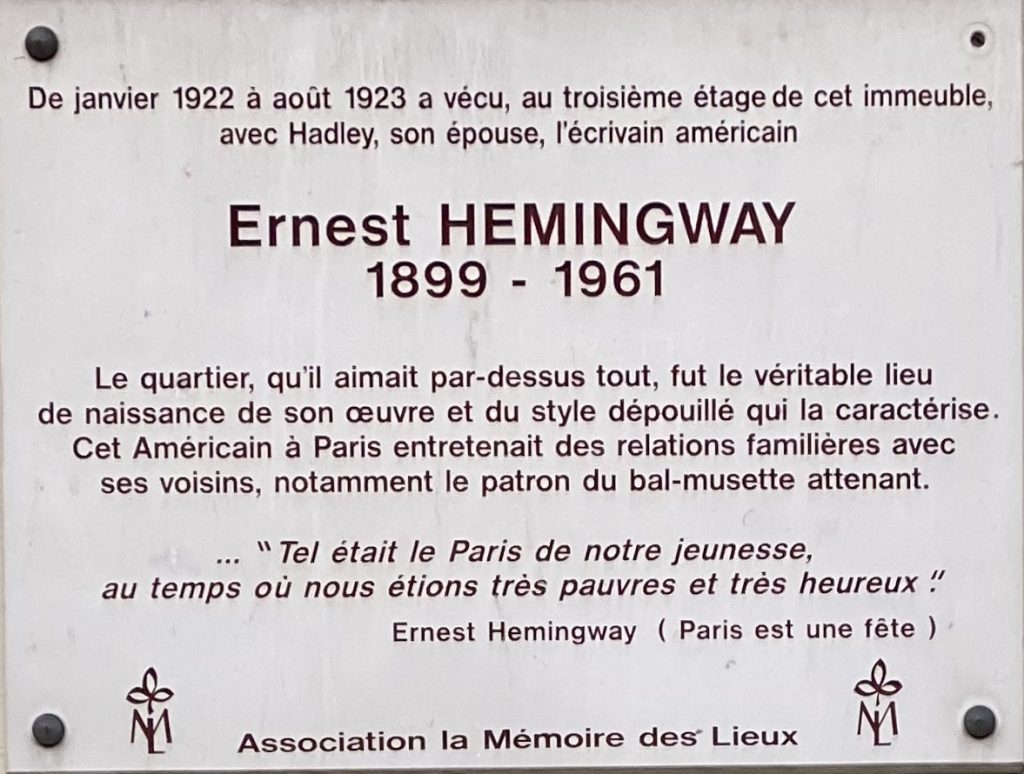
I live in the center of Paris, in the 5th arrondissement. It’s an area well documented by many writers. In the Latin Quarter, just around the corner, a young Ernest Hemingway lived with his wife Hadley in 1921. This was where he coined the famous quote, “If you are lucky enough to have lived in Paris as a young man, then wherever you go for the rest of your life, it stays with you, for Paris is a moveable feast.” When friends come and visit, it’s one of the very first places I show them!
Being restricted to 1 km of my home, admiring this moveable feast was becoming a real challenge. As many know, Paris is a city of perspectives, of wide boulevards where stunning architectural masterpieces mirror one another in visual form, space, and order. How was I going to survive being restricted to 1 km?
When visiting Bhutan, I always tell my guests that it isn’t a country to explore in a hurry. You must stop, smell the flowers, breathe in the remarkable gentility. You must look around you, as there is no point in hurrying. Suddenly it came to me…why shouldn’t I do the same now, here in Paris?
With a lack of traffic, there was a sudden peace and tranquility in this city of 2½ million souls. For once, I could hear birdsong instead of the cacophony of cars, sirens, and people. I could walk in the road without fear of being killed in an instant! Within those first few days of walking in my neighborhood, I began to realize that I have never closely observed the details of this glorious moveable feast. I have never truly lingered, as I encourage my clients to do when I travel to other parts of the world.
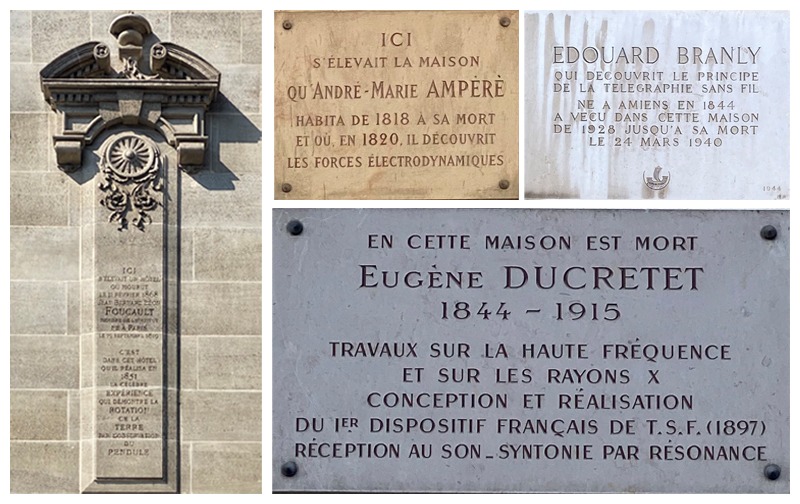
The first thing I began to notice was the plaques that describe where certain notable people have lived, stayed, or died. Among these were scientists like André Marie Ampere and Léon Foucault. Ampere made the revolutionary discovery that wire carrying electric current can attract or repel another wire next to it that’s also carrying electric current. The physicist Foucalt conceived of the pendulum as an experimental device to demonstrate the Earth’s rotation.
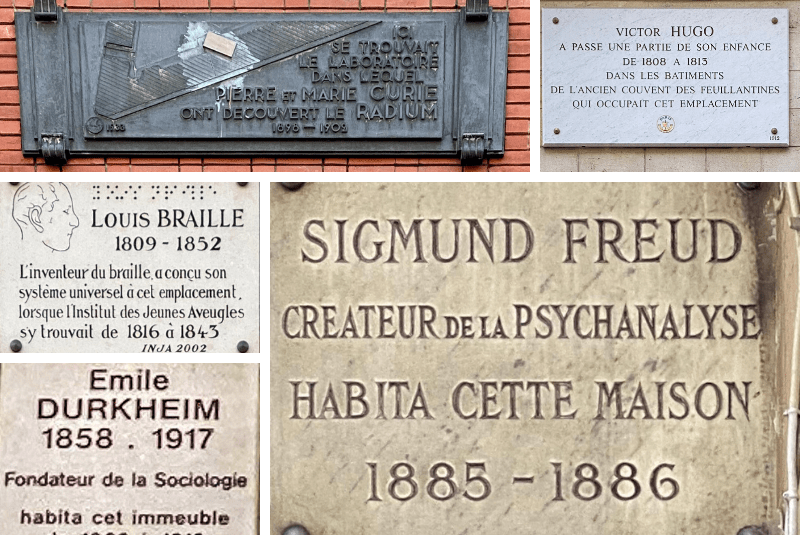
I learned that for a short time, Sigmund Freud lived opposite where I now have my apartment. In the nearby streets, Louis Pasteur and Marie Curie ran their laboratories and made discoveries that would have a life-changing impact on the world. Two pharmacists, Pelletier and Caventou, discovered quinine just down the road.
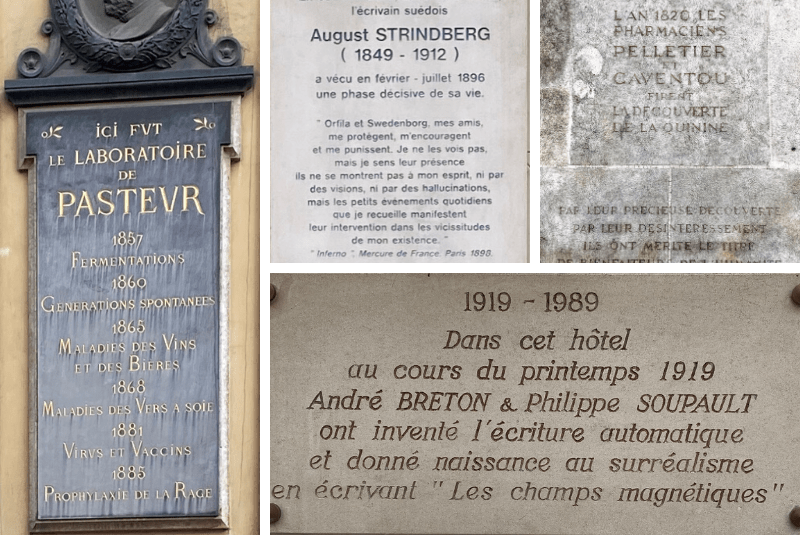
There were writers and academics, too. A very young Victor Hugo went to school nearby and Louis Braille conceived his universal language for the blind while teaching at a school for blind children a few streets away. Emile Durkheim, considered to be the father of sociology, lived in the area, as did August Strindberg, the Swedish playwright, during a very decisive time in his life. And in the spring of 1919, in a nearby hotel, André Breton and Philippe Soupault gave surrealism its beginning.
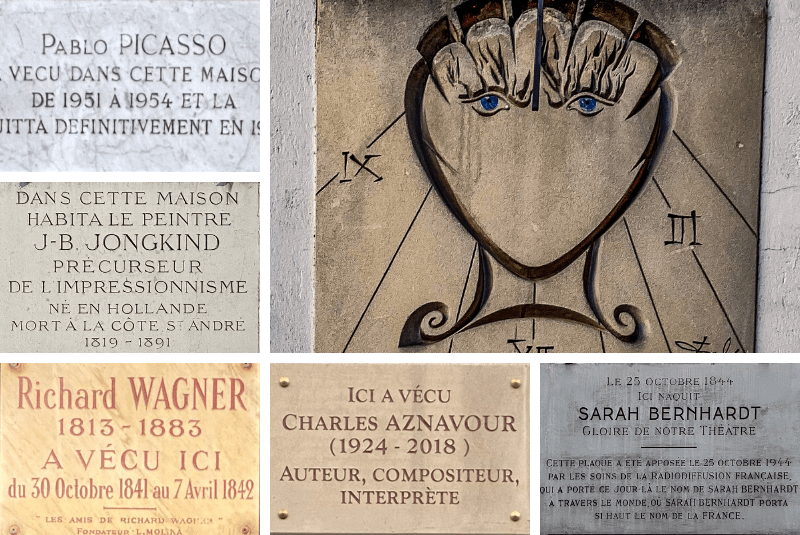
I discovered many artists as well, notably Pablo Picasso who, while living in Paris in 1937, painted his masterpiece “Guernica.” Johan Barthold Jongkind, considered by many to be the pioneer of Impressionism, lived nearby. Paris has 120 sundials scattered across the city, but only one is designed by Salvador Dali, and that one, a fanciful concrete concoction inaugurated in 1966, adorns the façade above a shop in my neighborhood that was once owned by one of Dali’s friends.
Then there are composers like Richard Wagner or famous singers such as Charles Aznavour and the actress Sarah Bernhardt, who spent some of their formative years in my neighborhood. What a revelation, to find all these extraordinary figures lived within 1 km of where I now live!
Strolling one day, I found the names of two notable women, neither of whom one has heard much about. Grace Whitney Hoff was born in Detroit into one of the most prominent families of the city, married John Jacob Hoff in 1900, and in the same year moved to France. She used her fortune to support many philanthropic causes, and during WWI she took care of wounded soldiers and founded a rest home for war widows. This particular plaque, however, commemorates her founding the very first hostel in Paris for international young women students so that they could study without fear and live in good conditions. The other woman was the bisexual French novelist Edith Thomas, who joined the resistance during the war, and who possibly inspired a character from the erotic novel Story of O.
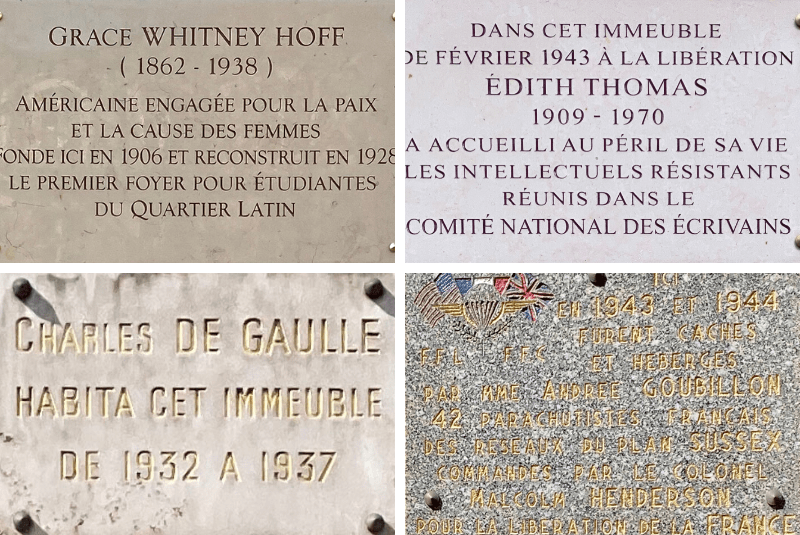
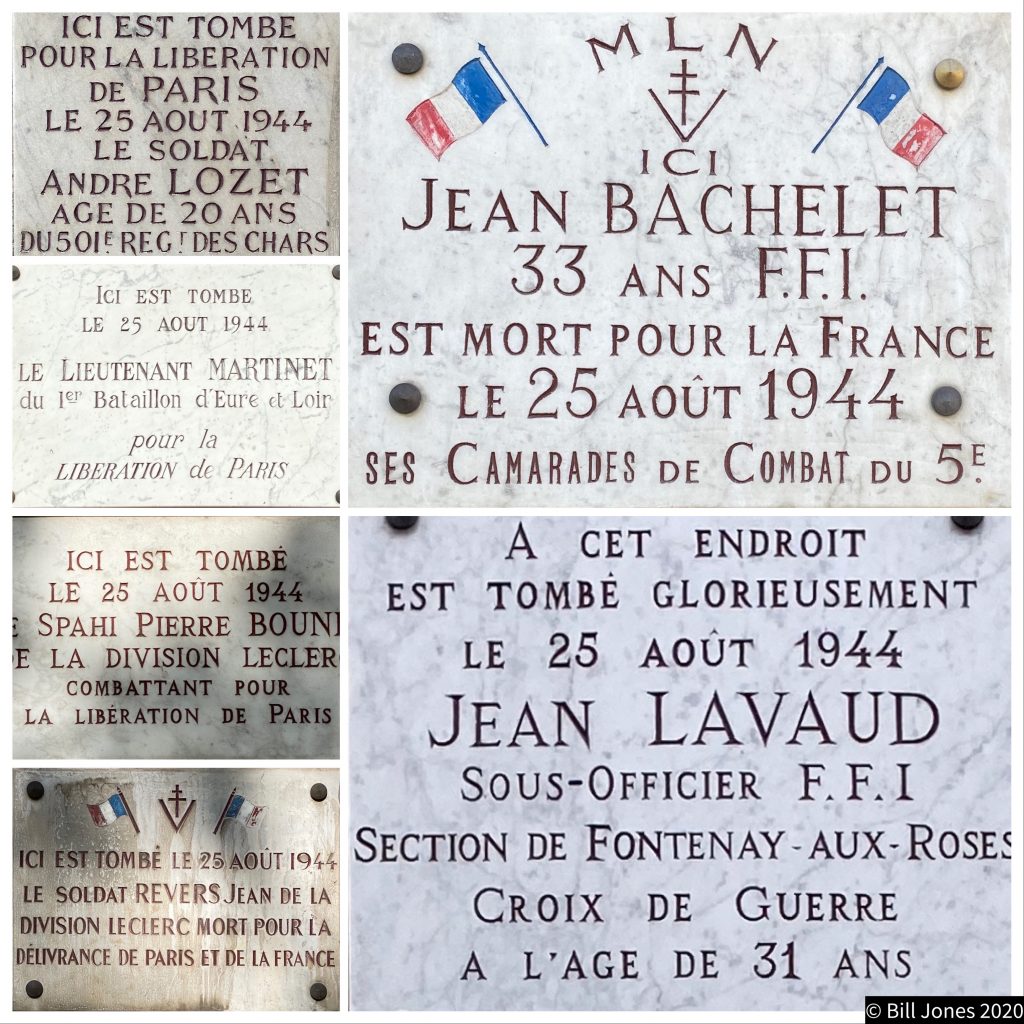
I discovered that Charles De Gaulle lived close by and this led to my taking notice of the many plaques dedicated to young men who lost their lives in the Liberation of Paris in August 1944, or those who were deported to concentration camps in the years before. While on the subject of WWII, I also discovered another gem concerning a certain Madame Andrée Goubillon, who owned the former Café de l’Electricité. Here she sheltered dozens of reconnaissance agents who parachuted into France in February 1944 as part of Operation Sussex. After the war, it was renamed the Café des Sussex. After Mme Goubillon passed away, the bistro closed and was never reopened.
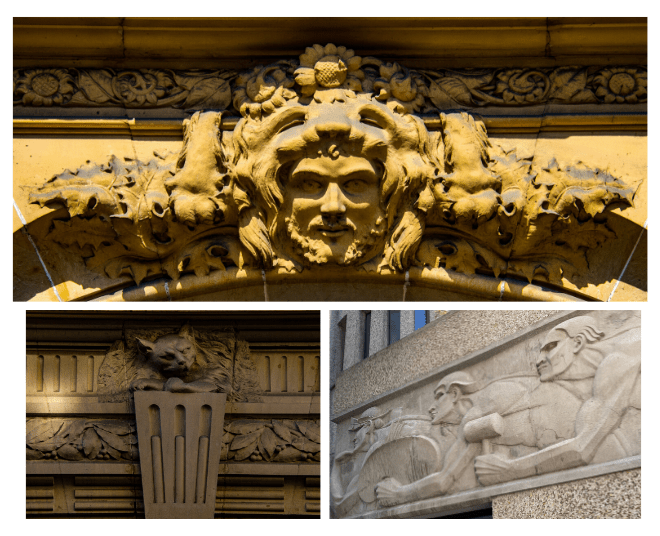
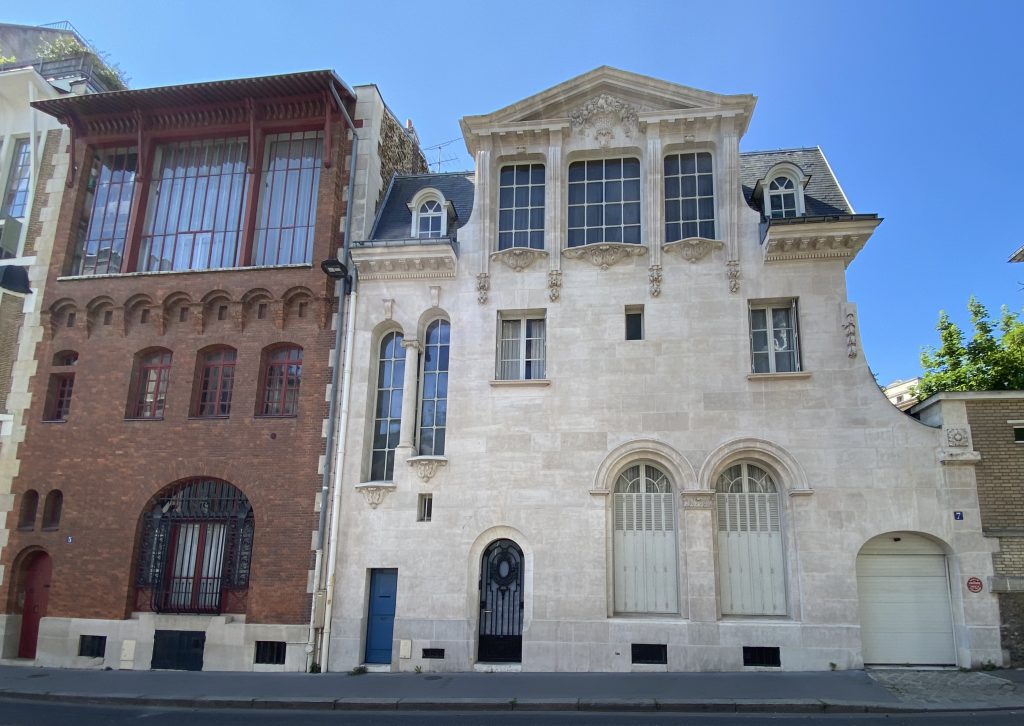
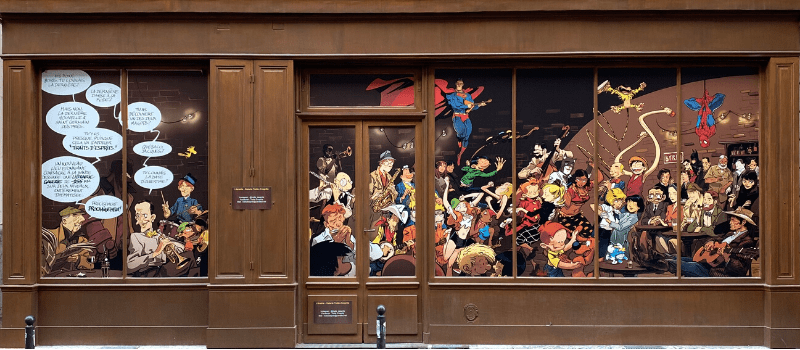
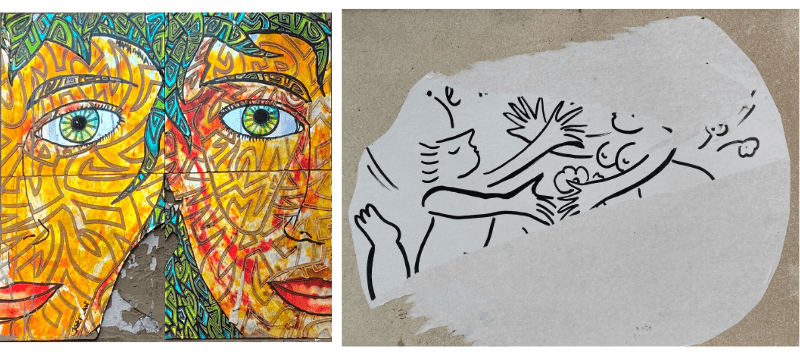
I have also taken a great deal more notice of the architecture, not famous buildings like the Arc de Triomphe, the Grand Palais, or the Eiffel Tower, but delicate masterpieces of Art Nouveau or Art Deco, or a decorative mascaron face above a window or doorway. There’s also the artistry and invention of street art, shop fronts, and window displays.
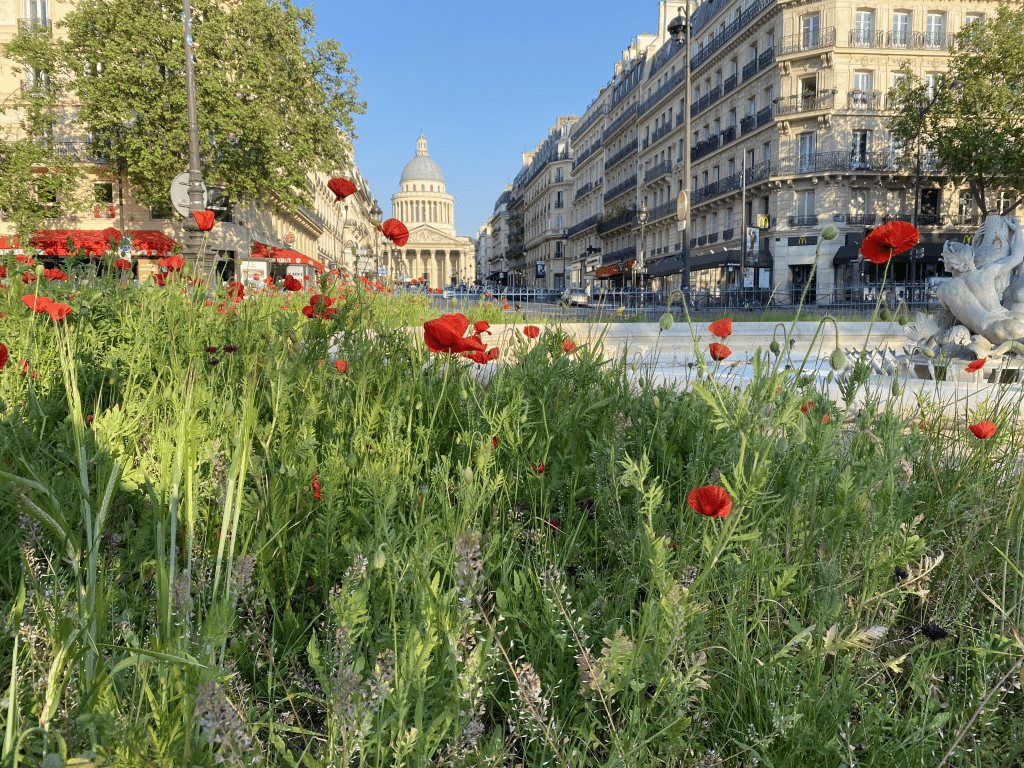
Ella Fitzgerald sang, “I love Paris in the Springtime, I love Paris in the Fall,” and my goodness, this lockdown springtime has been spectacular. The Luxembourg Gardens, perhaps the loveliest park in the whole of Paris, is just around the corner from my apartment. It is closed, along with all the parks of Paris. Yet around the Gardens, I’ve witnessed a spectacular display of the red and white candlestick blossoms of the chestnuts and blue paulownia trees, the last flush of tulips and poppies, and the perfume of lilac blissfully replacing the smell of diesel fumes.

Every day as I meander and linger, I see something new. I realize I have missed a plaque or notice something new in a shop window. I am struck by how much we pass by in our lives when we are occupied with something else or simply too busy to care or look. This confinement has taught me a lesson in observation, in taking time to linger, to advance that French talent of being a flaneur, and to observe in silence.
Today, for example, I looked closely in the shop window of an antique bookseller and noticed an old historic and artistic dictionary of the Rose. Delicately placed on the pamphlet was a dried white rose—almost as though it had been placed there by the author in appreciation of the beauty of this flower.
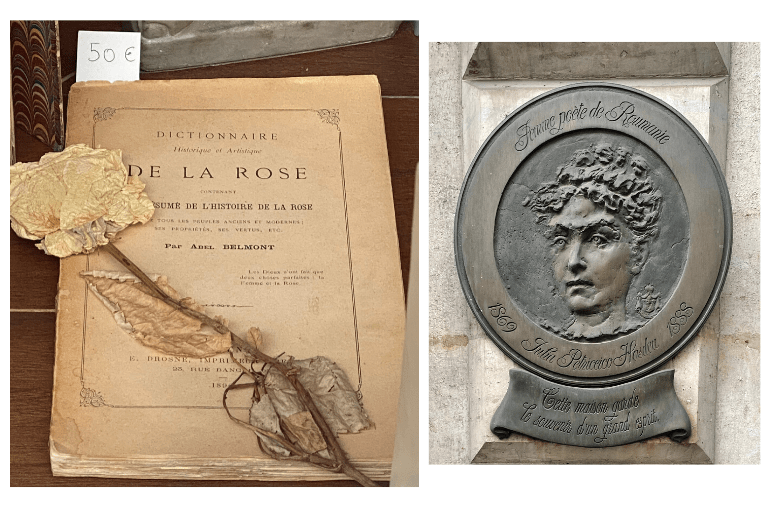
I found this gesture almost overwhelming, but then a short while afterward I found a plaque dedicated to a young Romanian poet Julia (Lulia) Hasdeu. She was completely unknown to me, so I Googled her on the spot. She was a young gifted poet who at the age of six wrote a study of the life and work of the Romanian hero Michael the Brave. Her mother took her to Paris in 1881, and in 1886, at the age of 17, she enrolled at the Faculty of Letters and Philosophy of the Sorbonne University, where she was the first Romanian woman to study. Two years later, she contracted tuberculosis and died. She was 19. Her father dedicated the rest of his life to her memory and built a castle in Romania with the “spiritual guidance of his daughter,” with whom he supposedly communicated until the end of his life.
I burst into tears as I thought of similar losses felt by thousands of families similarly torn apart in grief during this coronavirus epidemic.
In the late 1970s and 1980s, I had the privilege of leading some of the first Western groups to the Himalayas, to Kathmandu, and also to Tibet. These memories came flooding back when suddenly at the very west of my 1 km radius, in St Germain, I noticed a plaque dedicated to Philippe Édouard Foucaux, a French Tibetologist who published the first Tibetan-French dictionary, and who was the first Tibetan teacher in Europe. He collaborated with Sándor Csoma de Kőrös, the Hungarian philologist and orientalist and founder of Tibetology, who had written the first Tibetan-English dictionary and grammar book.
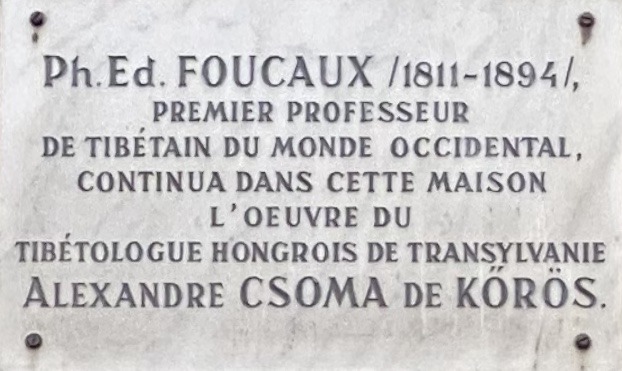
To the extreme south of my 1 km radius, near Port Royal, is a memorial to Francis Garnier. His ashes were brought back from Hanoi and interred at the base of his dedicated statue. In the late 1980s, as the guns of the Khmer Rouge could be heard while I was at Angkor Wat, I read about this great explorer who traversed thousands of miles of the Mekong and Yangtse rivers in 1870. Only now, however, did I learn that a year earlier he shared the Geographical Congress award in Antwerp with none other than David Livingstone, who was earning his fame in Africa.
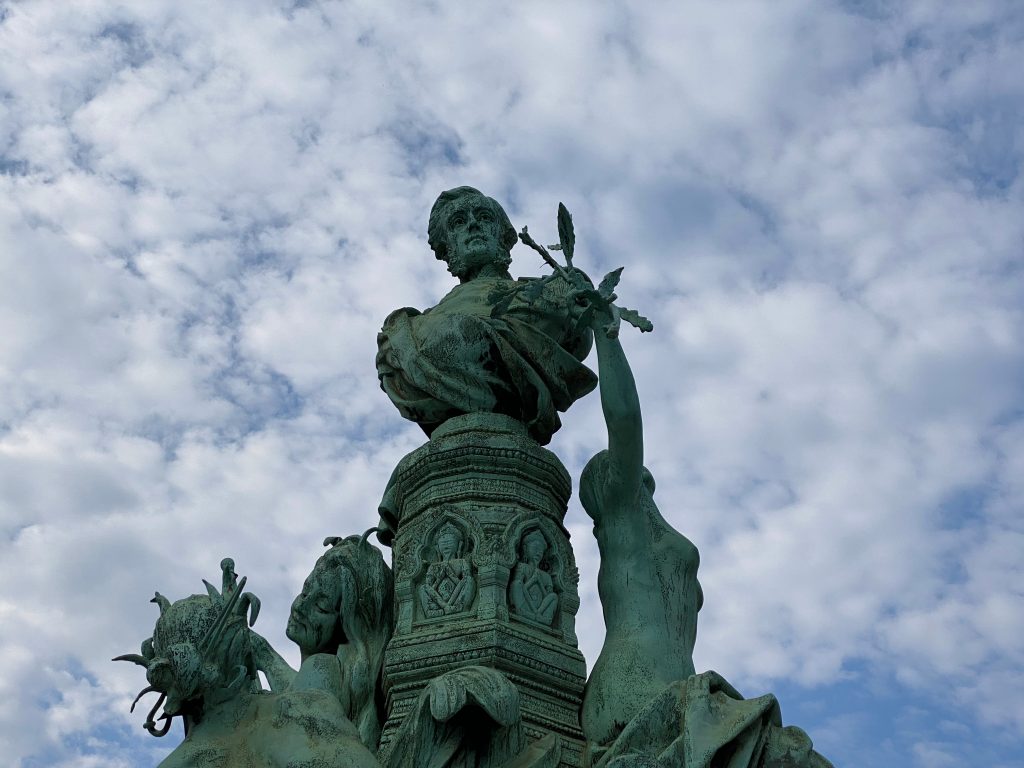
The Institut du Monde Arabe lies 1 km to the east of my radius. Founded in 1980 by 18 Arab countries, it is a place I have visited frequently, given my regular trips to Pakistan, Saudi Arabia, and hopefully soon Algeria. In 1989 this striking building, designed by Jean Nouvel, received the Aga Khan Award for Architectural Excellence.
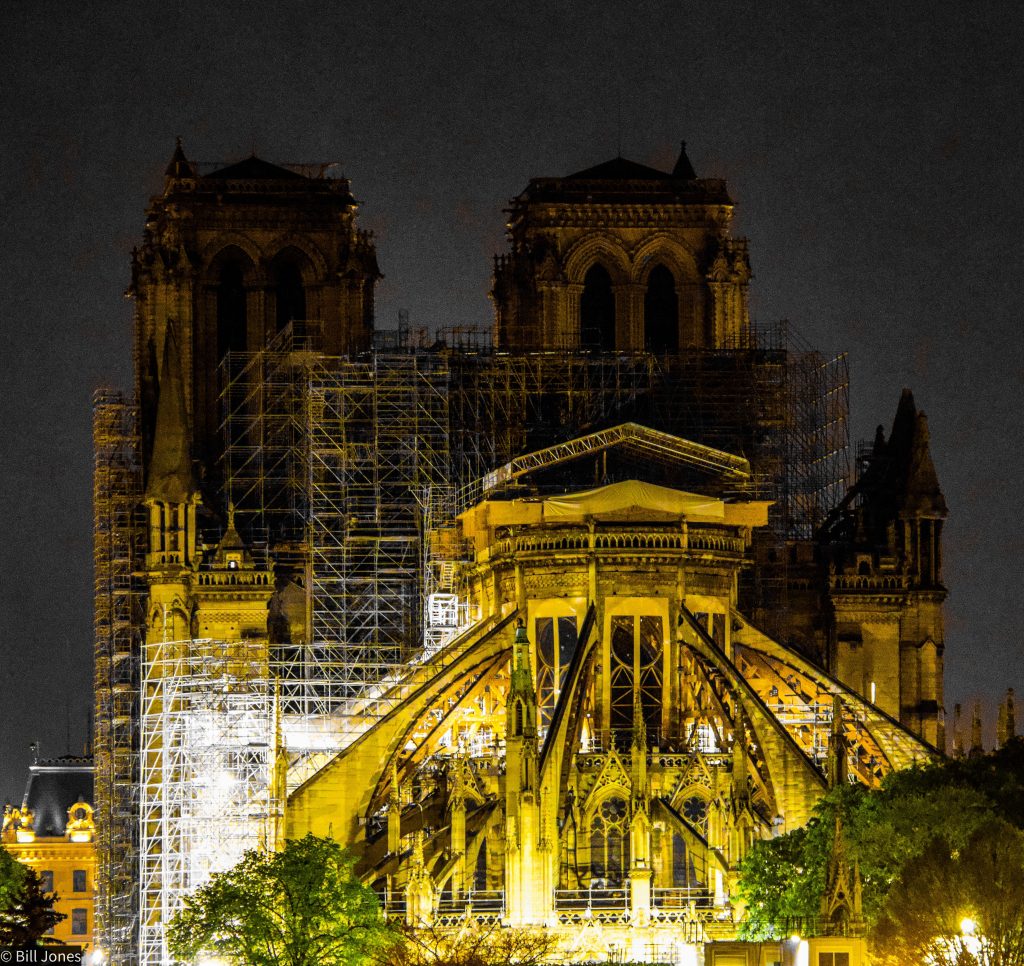
In complete religious contrast, just 1 km to the north stands Notre-Dame, recently described as the soul of France by author Agnès Poirier. During this pandemic period, we have mourned the first anniversary since the inferno that ravaged “Our Lady of Paris.”
Of course, I long to resume my ventures farther afield and continue my exploration of the world through the eyes of my guests and fellow travelers, but what I have come to realize during these 7 weeks of confinement within 1 km of my home is that I have never really stopped traveling.
* * * * *
A British-born, Paris-based explorer, raconteur, and widely respected guide, Bill Jones has led countless tours across the globe over the past four decades. He is deeply knowledgeable, experienced, caring, informative, and fun. Bill’s commentaries during visits to monuments and his pre-dinner talks are entertaining and informative and have been greatly appreciated by our travelers. He’s been the esteemed GeoEx trip leader on some of our Pakistan and Algeria tours.
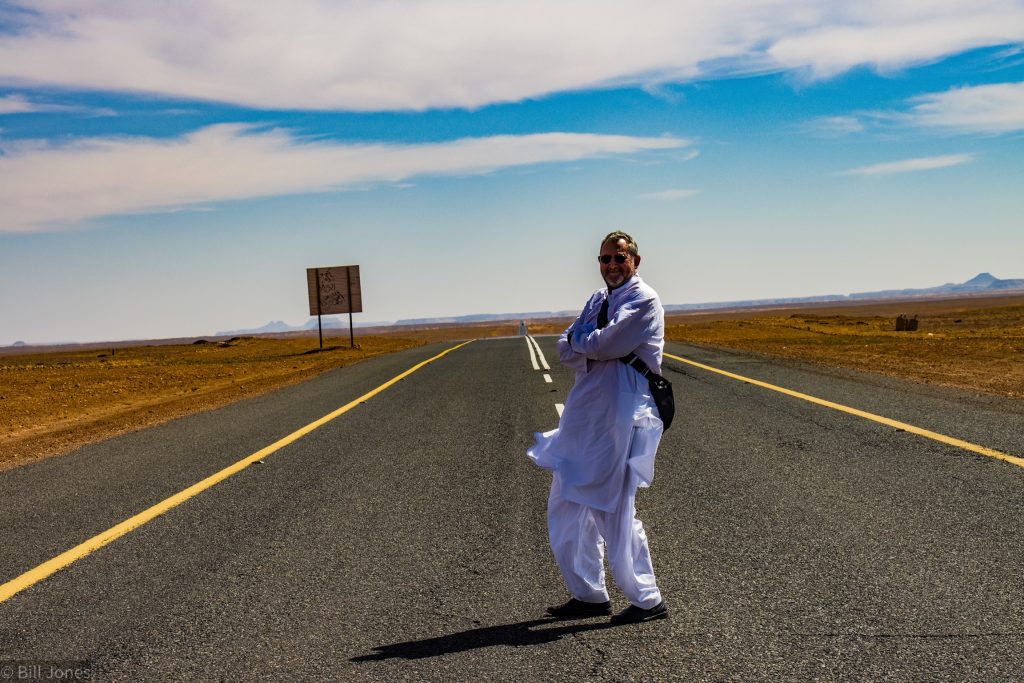
To find out more about going on a GeoEx adventure with Bill Jones, call our travel experts at 888-570-7108.
Dear Bill I find myself trembling while reading your exploration around your neighborhood, traveling between centuries, history , arts, sciences , architecture , countries, but all coming back to the beauty of the human being and nature of which we are part… you are a real humanist ! Thank you ! Merci infiniment !
there is always much to see and reflect upon Irini………..we simply need to look.
Dear Bill, It is a lovely tribute to all these well-known personalities and unknown persons who enriched your urban walks! I would like to wish you to have soon more walks but within a radius of 10 000 km….
Dear Véronique, thank you! As Lao Tsu said, “each journey begins with a single step” and so too will ours in the very near future.
An astounding factual and down to earth tribute to your “home surroundings”. Thank you Bill for your excellent raconteur style embodying your spirit, feelings and appreciation . Can’t wait for your next addition. Count me in when you go to Press. A bientot mon ami.
Dear Sue, there is certainly more to come and comments like yours give me incredible encouragement. There is, as you and I both know a lot to experience out there, and actually you don’t have to go that far to find it. May you and Noel be back on the road again soon. Looking forward to seeing you hopefully in the not too distant future. Yours Bill
Absolutely fabulous! Bill Jones is a gem and reminds us of the true spirit of exploration- no matter the radius– a curious mind can discover endlessly!
Thanks Carroll for your kind comments. A friend here in Paris reminded me of an old French proverb from 1611 “On cherche quelquefois bien loin ce qui est bien près.” It rings so true today as ever. Hope to see you on the road soon. Bill
Ah ces grands voyageurs qui regardent à peine ce qu’il y a tout près de chez eux !
C’est l’art de voyager lentement “slow travel” qui est le résultat Philippe. Et personnellement j’ai bien apprećié ça à mon quartier pendant ce confinement. Bill
when you slow down, you suddenly see the details of our world. During our “shelter at home”-time in Cologne i discovered the world in my garden. It is quietly – no planes – but you hear the birds of the forest next to our garden. And observe the growing blossoms – its spring time.
Hope to see you soon again and share thoughts about the small world
Andreas and Henni (Cologne – Deauville)
It’s so true Anreas & Henni, one of things that struck me most in Paris was the sound of birdsong in the heart of the city. Now as we loosen the constraints of confinement it becomes less and less noticeable. Looking forward to seeing you both in the not too distant future. Bill
Such an interesting article. We may not all be fortunate to live somewhere that is overflowing with history, but it does show what we can all learn about our own environment if we take the time to open our eyes and actually think about what we see. Thanks, Bill.
We so often go searching far and wide for something that is in front of our eyes. However that shouldn’t prevent us from travelling once again as soon as we can. We might however, just might, appreciate it a little more when we do. Bill
An excellent omnibus of You, your life, and Our Beloved Paris.
Thank you Debs, looking forward to travelling with again soon. Bill

